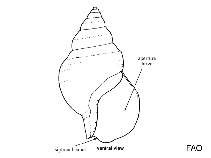Ranella olearium (Linnaeus, 1758)
Little frog tritonGoogle image | No image available for this species;
drawing shows typical species in Buccinidae.
Classification / Names Common names | Synonyms | CoL | ITIS | WoRMS
Gastropoda | Neogastropoda | Buccinidae
Environment: milieu / climate zone / depth range / distribution range Ecology
Benthic; depth range 100 - 800 m (Ref. 83435). Deep-water; 49°N - 41°S, 59°W - 179°E (Ref. 106831)
Distribution Countries | FAO areas | Ecosystems | Occurrences | Introductions
Indo-West Pacific, Atlantic Ocean and the Mediterranean.
Length at first maturity / Size / Weight / Age
Maturity: Lm ? range ? - ? cm Max length : 20.5 cm DL male/unsexed; (Ref. 83435)
Life cycle and mating behavior Maturity | Reproduction | Spawning | Eggs | Fecundity | Larvae
Main reference
References | Coordinator | Collaborators
IUCN 2006 2006 IUCN Red List of Threatened Species. www.iucnredlist.org [Accessed 04/07/2007]. (Ref. 7800)
IUCN Red List Status
(Ref. 130435: Version 2025-1)
CITES status (Ref. 108899)
CMS (Ref. 116361)
Threat to humans
Human uses
| FishSource |
Tools
More information
Diet composition
Food consumption
Predators
Max. ages / sizes
Length-weight rel.
Length-length rel.
Length-frequencies
Mass conversion
Abundance
Internet sources
BHL | BOLD Systems | CISTI | DiscoverLife | FAO(Publication : search) | Fishipedia | GenBank (genome, nucleotide) | GloBI | Gomexsi | Google Books | Google Scholar | Google | PubMed | Tree of Life | Wikipedia (Go, Search) | Zoological Record



